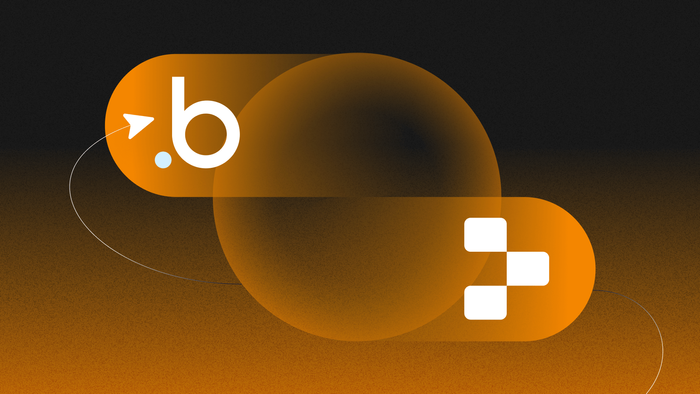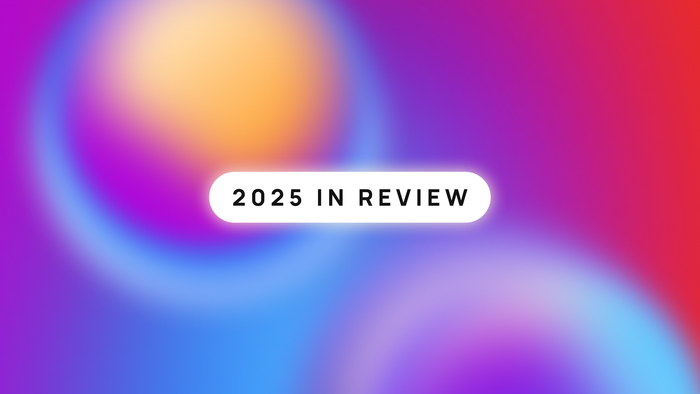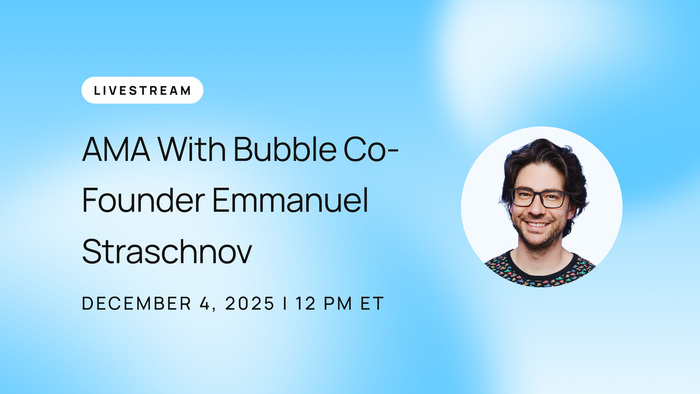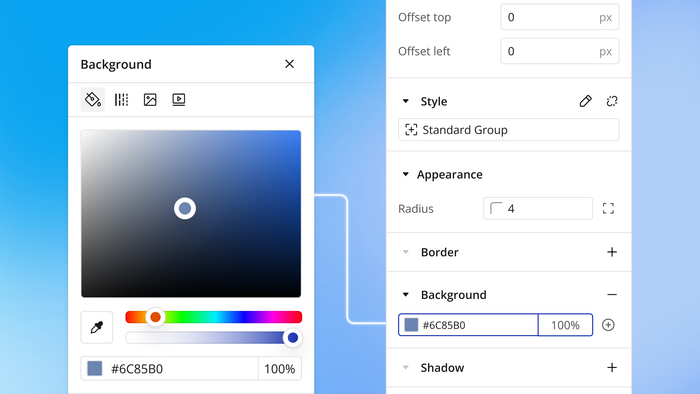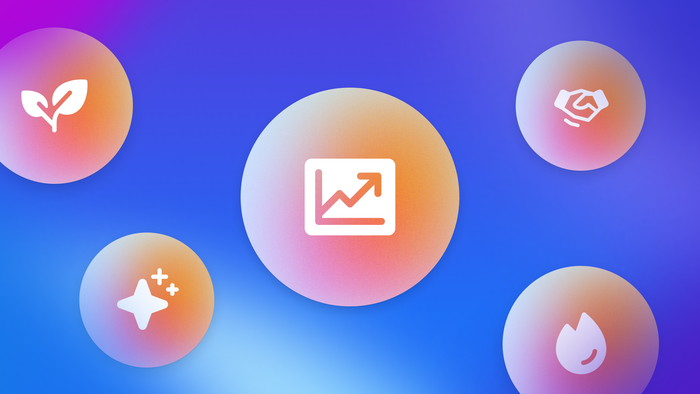No-code promised to make building software accessible to a broader audience — and it did! Now, AI builders are on the scene and improving constantly, making software development even easier and faster.
Given the rise in the combination of no-code and AI tools for building software, we knew it was time to test out the most popular options.
Bubble and Replit are popular tools among developers and non-developers alike for building apps with AI, so we put them up against one another to see which would perform best for different use cases.
Bubble is an AI visual development platform that allows anyone to build and launch fully functional web apps without code. Bubble combines AI tools to help you escape the blank page and start building faster with visual programming tools to allow you to customize every aspect of your app. This way, anyone can take an app from build, launch, and grow an app while remaining in control the whole time.
Replit is an all-in-one programming environment + AI chatbot that allows you to code (or generate code via AI), iterate, collaborate, and host your app all in one place. It gives you a streamlined experience, full access to your code, and flexibility. It supports 30+ programming languages and two AI tools — an Agent for your initial build and an Assistant for continuous coding help and iteration — to take you from generation to iteration and beyond.
Bubble vs. Replit: Key factors
Before we dive into the Bubble and Replit platforms themselves, there’s one major factor to keep in mind when choosing an AI builder, and that’s the 80% rule.
In our comparisons, we focused not only on that first 80% — the initial output of the AI-generated code or app — but also on how well the platform helped builders deal with that last 20%. That is:
- How easy does the platform make it to iterate on and customize your app?
- Do you ever have to deal with code, or can anyone understand their app at every point?
- Does the AI cause builders to get “stuck,” or do you have full control throughout the whole process?
- Is scaling or building an app on this tool cost-prohibitive due to hidden fees related to AI usage?
These are especially big concerns for users without technical expertise. Technical users may be able to hop in and edit code manually when AI gets stuck, but non-coders may find themselves stuck in “prompt purgatory” — endlessly prompting the AI but not getting the results they want.
So how do Bubble and Replit stack up on the first 80% and the crucial 20%? That’s what we’re diving into below, but let’s take a quick look at some key factors and comparisons:
| Feature | Bubble | Replit |
|---|---|---|
| Initial output quality | ⭐⭐⭐⭐ | ⭐⭐⭐💫 |
| Design capabilities |
⭐⭐⭐⭐ Responsive design and drag-and-drop visual editor to make pixel-perfect UI, but missing AI-powered iterative editing (for now!). |
⭐⭐ Responsive design but no visual editor. |
| Collaboration | ⭐⭐⭐⭐⭐ Real-time collaboration with adjustable permissions for each user. |
⭐⭐⭐⭐⭐ Full IDE with Github integration. Note that Replit collaboration links always provide edit access. |
| Backend and database support |
⭐⭐⭐⭐ Native backend and database that doesn’t require technical expertise or extra costs to set up. |
⭐⭐⭐ Built-in database; setup can be confusing for nontechnical users |
| Security and compliance |
⭐⭐⭐⭐ Bubble offers enterprise-grade security features, including SOC-II and GDPR compliance, advanced encryption and monitoring, and custom privacy rules. |
⭐⭐⭐ Strong platform-level security, but app-specific security is up to the developer and has to be coded manually. |
| Deployment/hosting |
⭐⭐⭐⭐⭐ One-click deployment and native hosting. |
⭐⭐⭐⭐⭐ One-click deployment and native hosting. |
| Technical expertise |
⭐⭐⭐⭐⭐ Best-in-class for developers and non-developers alike. |
⭐⭐⭐ OK for nontechnical and moderately technical users (technical background very helpful). |
Replit is a flexible full-stack development platform (it supports 30+ programming languages) that gives developers full control over their code. Replit provides AI support for both generating code and iterating on it. The integrated development environment (IDE) will be familiar to technical users, which can decrease the learning curve and make it easier to feel comfortable in the platform.
However, Replit is geared more toward experienced developers. Without any kind of visual builder or editor, you’re required to have some level of coding knowledge to debug and refine your code due to AI’s inconsistent and often buggy output. Many of our testers also noted that Replit has a bit of a “jack of all trades” problem. Although “doing it all” is certainly a strength for Replit, it also means that it’s not as specialized in individual tasks like UI generation, debugging, or visual editing as other tools. Finally, cost and privacy concerns can both be barriers for startups thinking about using Replit.
If you’re serious about building and scaling your app but don’t have a lot of technical experience, Bubble is the best choice for you. Built for speed and scale, Bubble provides a visual editor that ensures no-code stays codeless while giving you full control and customization. It also offers an all-in-one environment where you can go from generating code to building and customizing a fully-functional app to launching and scaling.
Bubble also offers production-grade tools like privacy tooling, enterprise-grade scaling and security, and built-in databases and hosting. Even better, you don’t have to pay for anything until you’re ready for launch.
Initial output quality
When you’re choosing between AI app builders, the quality of the app output is a major factor. Does the initial output get you most of the way there, or does it need lots of iteration and refactoring? How well does the AI interpret prompts? What’s the overall quality of the original output?
That’s the first factor we’ve considered in our comparison.
Bubble AI-generated apps
Obviously, we’re big fans of our own platform. But what are real users experiencing? To find out, we talked to eight different users who were building AI-generated apps with Bubble and had them analyze output quality in seven core areas.
Here’s how Bubble scored:
- Color, branding & consistency: 3 / 5
- Spacing & layout: 4.5 / 5
- Copy, content & context: 4 / 5
- Navigation and orientation: 4 / 5
- Readability and typography: 4.5 / 5
- Feature completeness: 3.5 / 5
- Feature functionality: 3 / 5
Bubble delivers excellent UI, with high rankings across the board for elements like spacing and layout, navigating, readability, and copy. Users agreed their app’s frontend looked great from the first try, and found Bubble’s AI accurately interpreted their prompt without too much effort.
Bubble’s AI app generator just got even more powerful with Claude 3.7 Sonnet. Prompted yesterday? Try again now 😏 pic.twitter.com/uG0C6OGRGi
— Bubble (@bubble) February 25, 2025
Bubble generates more than just a beautiful frontend — it also creates workflows, databases, and real functionality for your app.
This is the tricky part, and our testers were split on how Bubble’s AI performed with feature completeness and functionality. Some gave Bubble top scores in these areas, saying that Bubble’s AI generated all the features their app needed and they worked perfectly. Others said that their app needed more iteration for feature functionality after prompting.
In general, this makes sense, as more complex app ideas are almost certain to need more iteration no matter what platform you use. That said, Bubble’s AI gets you about 80% of the way there in about five minutes, which gives you a huge leg up on development.
Replit AI-generated apps
Replit’s output generally had mixed reactions. In our testing, the UI and frontend generated was on par or slightly below other AI builders we tested. In short: it was just fine. Replit isn’t a design-focused platform, so it makes sense that some of our test apps came out very bare-bones from a design perspective and almost looked more like wireframes.
Features and functionality were also a mixed bag. Feature comprehensiveness was better on simpler app ideas, but once we tested more complex ideas, Replit struggled to add the necessary or expected features from the first output.
In general, user sentiment online notes that this is a common problem. Many reviews ask for more reliability and obedience to instructions, saying that Replit’s AI doesn’t always follow directions, even when prompted specifically. In addition, lots of users state that the AI Agent’s code is “bloated” or buggy, requiring extensive debugging.
Replit brands itself as an “all-in-one” development environment, but from many user responses (and our own tests as well), the “jack of all trades” approach means that Replit provides less consistent output in any one area. Sometimes the UI is great, sometimes it’s not. Sometimes the functionality is great, sometimes it isn’t.
Despite the unpredictability, on the whole, Replit is capable of producing a very functional MVP with multiple features and accessible code. In addition, AI-driven iteration (which we’ll get into more later) proved to be a strength for Replit.
Which has better initial output quality?
Bottom line: Bubble delivers excellent UI and basic features and functionality, which you can then iterate on visually. Replit provides a more moderate output across the board — not excelling in any one area, but providing a generally good output. Initial outputs from Replit can be iterated on manually or via AI chat.
App development workflow
What’s the actual process of creating an app with Bubble AI vs. Replit? That’s what we look at in this section.
How to create an app with AI on Bubble
Creating an app with Bubble AI has three basic steps:
1. From the AI app generator, input a prompt that provides a concise description of your app along with key features.
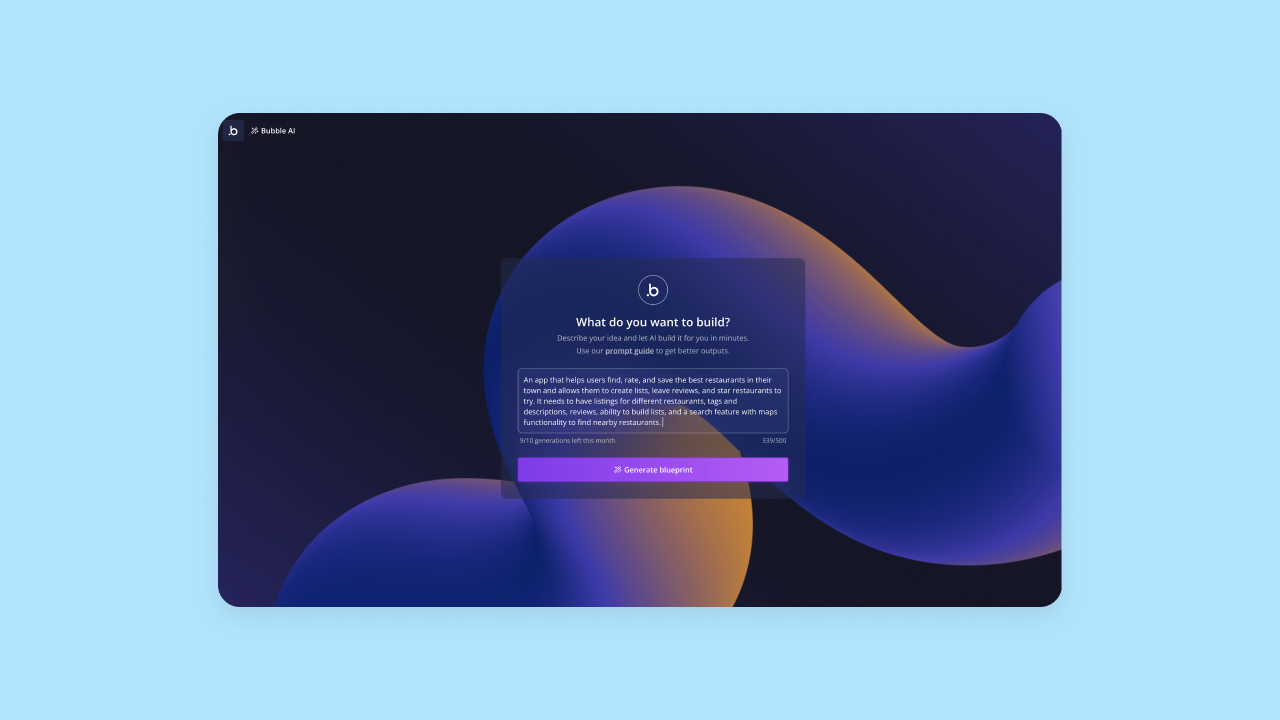
2. Bubble AI will interpret your prompt and double-check with you by giving you an outline of key features and tasks your end-users might do. If it didn’t quite capture your vision, you can edit this or add additional features at this stage. When the outline looks good, click Generate and AI will build v1 of your app.
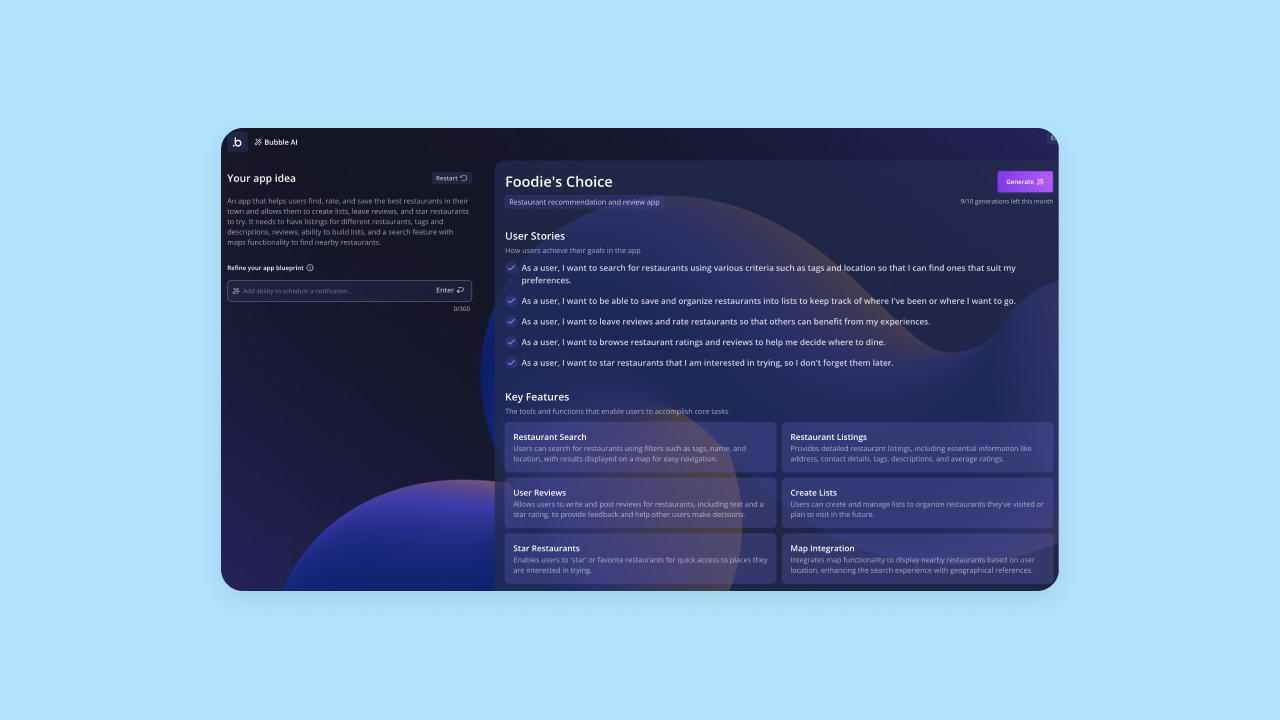
3. It takes Bubble AI around 5–7 minutes to create the first draft of your app. You’ll get a functional app that includes frontend UI, backend databases with sample data, and workflows. The features and functionality on your app should already work and be ready for more data and iteration.
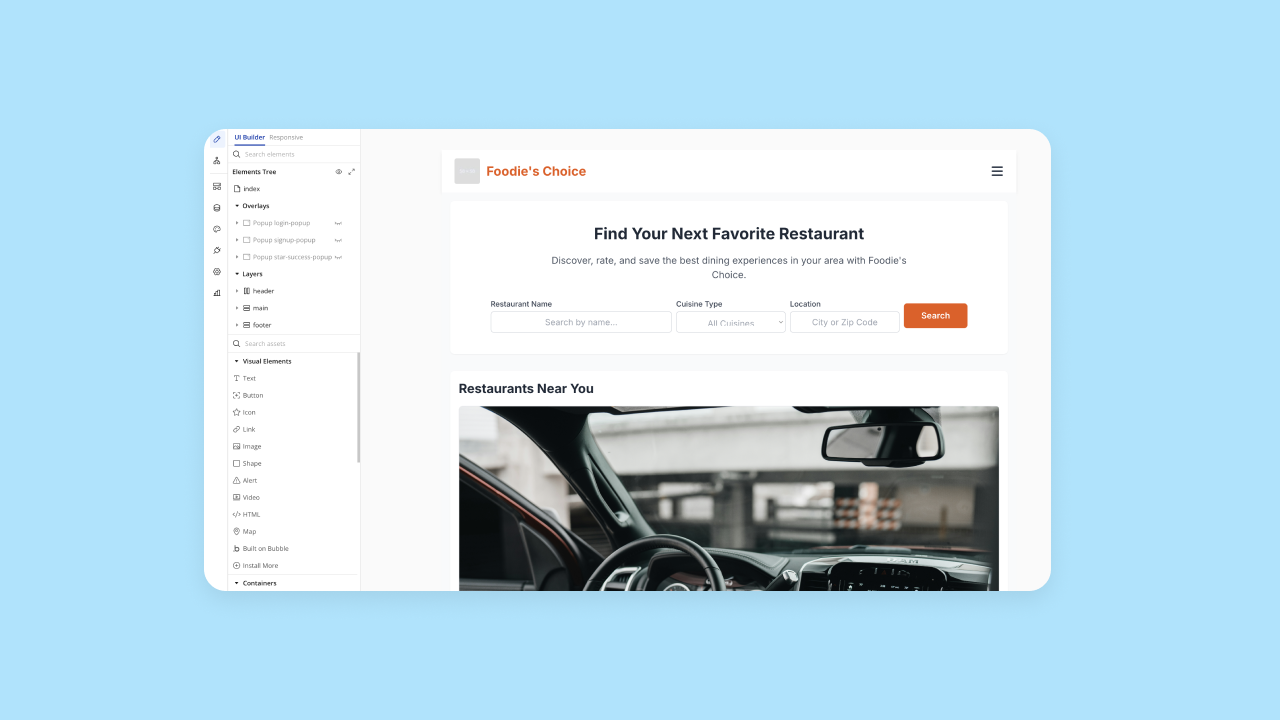
Once your app is generated, you’ll be taken to Bubble’s visual editor. You can see individual pages, workflows, and databases — and everything that’s been created in each — by toggling between editor sections on the left-hand toolbar. Everything is edited and managed visually, so you have full visibility and control of every piece of your app, without having to dig into the code.
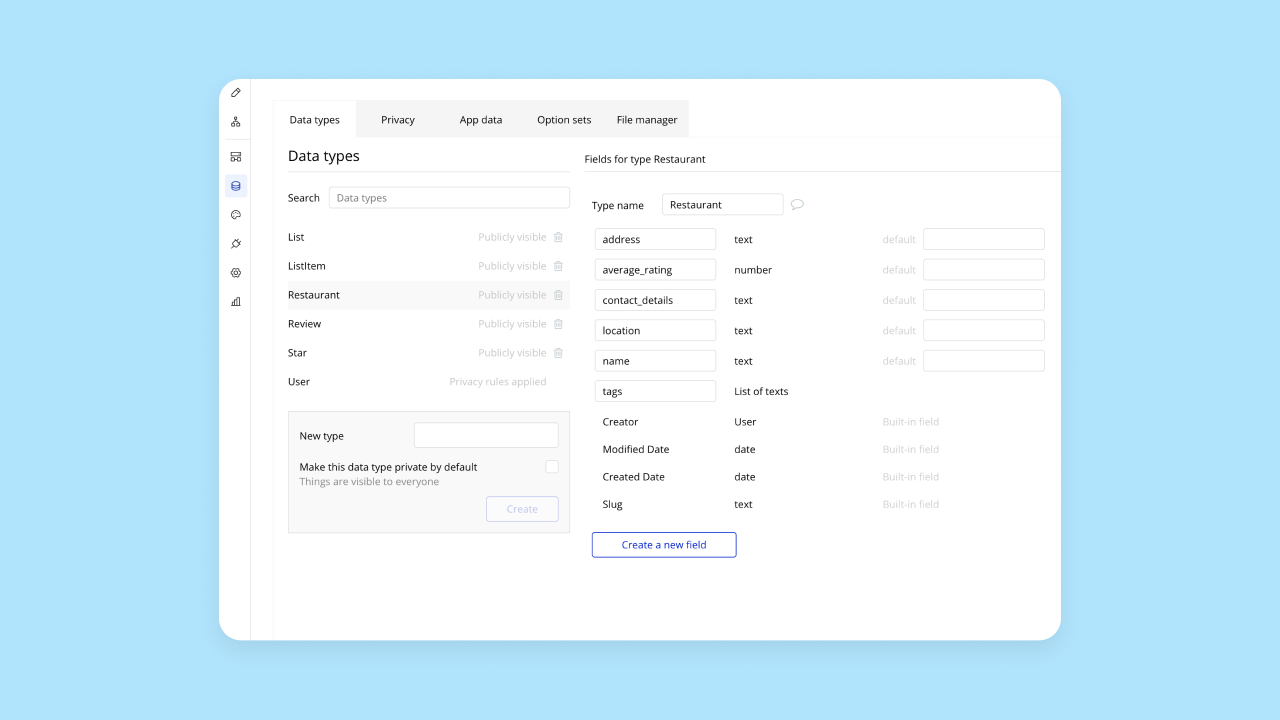
How to create an app with AI in Replit
Replit provides a similar process to app development. The main difference is that Bubble uses a visual-based programming environment, while Replit uses an IDE that juggles an AI chat, a text-based code editor, and a visual preview.
Here’s how it works:
First, prompt the AI with your app idea. Similar to Bubble, the AI will provide a quick outline of what it interprets from your prompt, and will also suggest additional features you may want.
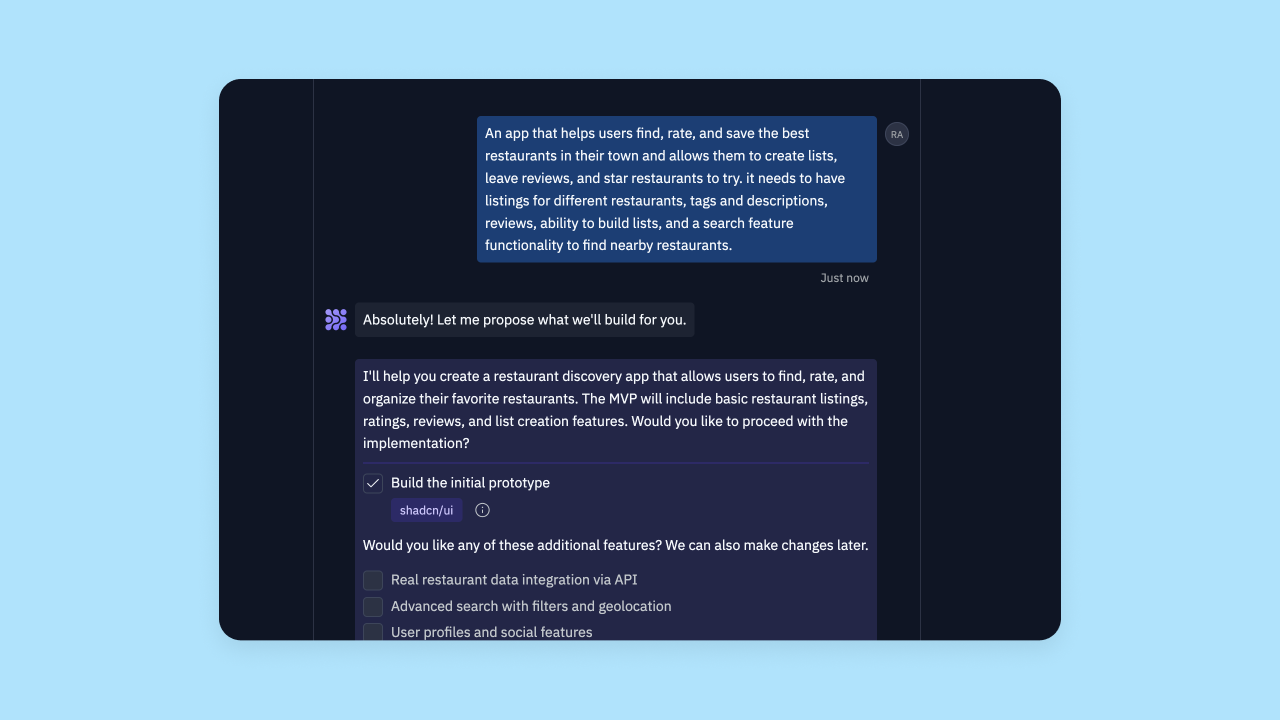
Once you approve the plan, the AI will start generating code. This took between 5–10 minutes from our testing. While the AI is working, you’ll be able to see the code generating in the right-hand view, while the AI chat keeps track of what’s been asked and completed.
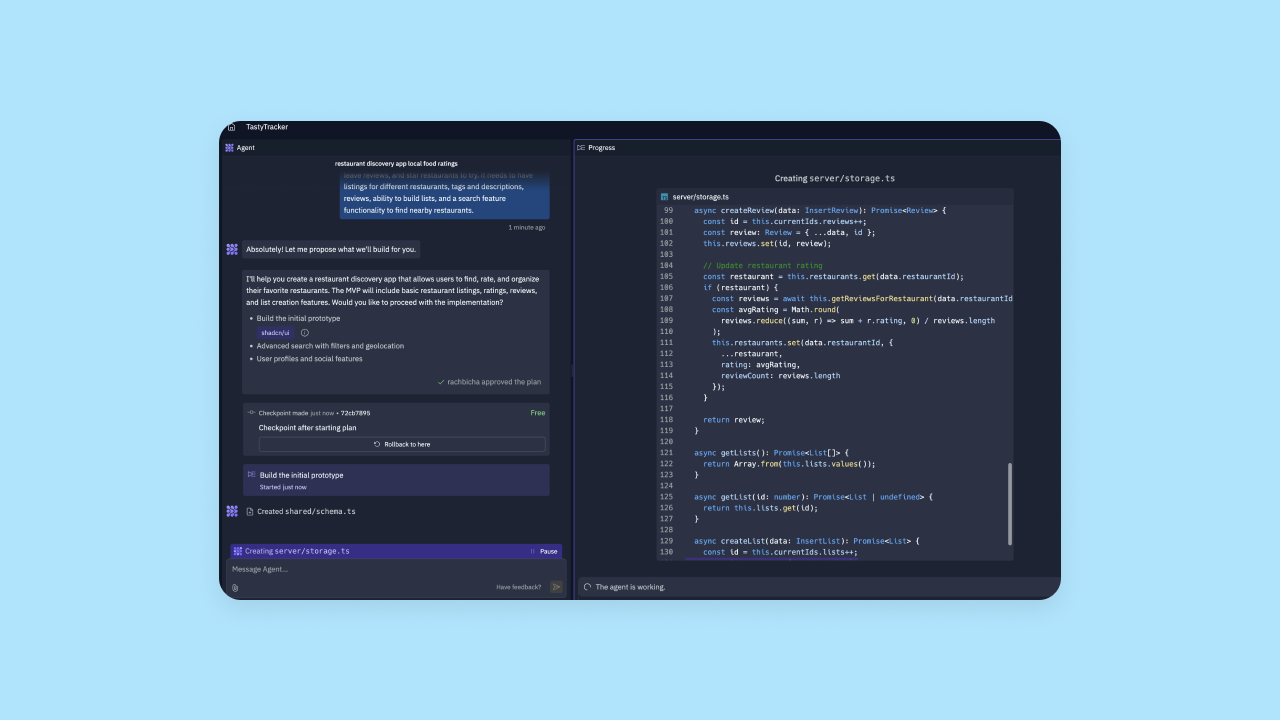
When the code has been generated, Replit will load an interactive web preview of your app in the right-hand view. On the left, you can continue to interact with the AI to make changes or iterate on what’s been created. You can also access the code directly on the right-hand view to edit the code manually.
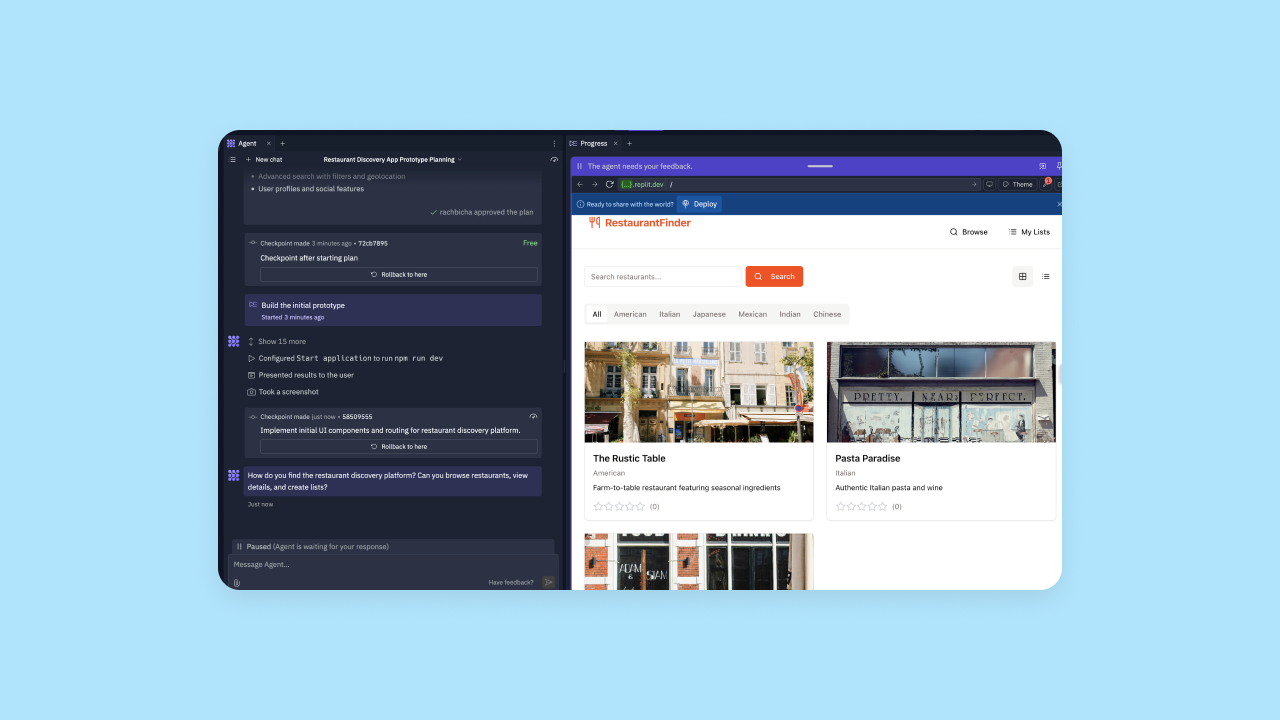
Overall, Replit provides a really nice IDE combined with AI tools. For more experienced developers looking for seamless AI integration to their development environment, Replit’s building experience can help check that box. However, Replit’s app development workflow can feel overwhelming for non-developers and has no visual development options.
Which is the better app development workflow?
Bottom line: Bubble and Replit provide similar app development processes, but Bubble uses a visual editor while Replit uses a code editor in an IDE. Beginners will likely feel more comfortable and confident in Bubble’s environment, while technical users will likely appreciate the familiarity of Replit’s IDE.
Design functionality
When it comes to the design of your app — and the design features of the platform — how do Bubble and Replit’s AI generators stack up? Are you able to create responsive designs? Is there a drag-and-drop visual editor? Is the experience truly no-code or do you need some technical expertise to finalize the design of your app?
Bubble design features
Bubble offers strong design features via the visual editor to make for a truly no-code experience. For example, you get:
- Responsive design capabilities: Easily design for web, mobile, and other screen sizes with automatic responsive design as well as manual breakpoints and layouts.
- Drag-and-drop visual design: An intuitive visual editor allows you to build and edit your design and make customizations without coding.
- Customization options: Bubble has an extremely flexible editor that gives you complete control over every pixel. Enterprise users love the ability to match your brand guidelines and website exactly, pixel by pixel. Founders and startups appreciate the ability to design their app exactly as they imagined it.
- Design imports: Already have a high-fidelity design in Figma or another design tool? Import it directly into Bubble and convert them seamlessly into a functional app.
Most useful, especially for non-programmers, is Bubble’s fully visual, drag-and-drop editor. You get full control over the look and feel of your app without having to code, which can speed up development and prevent you from getting stuck in AI-prompting loops.
Replit design features
Replit offers a very different approach to design and editing. It doesn’t offer drag-and-drop visual design functionality, or a visual design environment at all. Think of it more as an AI-enabled coding environment rather than a visual builder or a tool with extensive design features. However, Replit does offer some design features, including:
- Responsive design allows you to design for a variety of screen sizes, though Replit doesn’t have an easy way to create and deploy mobile apps.
- Multi-modal AI approaches mean you can prompt Replit’s AI agent with an image or a screenshot and the AI will attempt to build that interface in code.
Replit advertises itself as an “AI Visual Programming” approach, but keep in mind that their visual programming is much less visual than other AI app builders like Bubble. At its core, it’s still focused on code and uses a traditional IDE interface.
It’s not a design-heavy platform, and it doesn’t leverage a more beginner-friendly, intuitive UX design like Bubble or Lovable do.
Which is better for design?
Bottom line: Bubble comes out ahead in terms of design capabilities and ease of use. Bubble offers full drag-and-drop visual editing and extremely flexible no-code design customizations. Replit is more focused on providing a traditional IDE that requires coding or AI prompting to make design-focused changes.
Customizability
No app — whether human-made or AI-generated — is going to be ready to ship on the first try. Customization is key to making the app exactly what you have in mind.
Customization on Bubble
Customization is one of Bubble’s core strengths, and our AI capabilities build on this foundation of flexibility and control to give you even more tools to leverage. Bubble’s AI tools never lock you in to a single direction — they only give you more ways to speed up your workflow and overcome the blank-page dilemma, so you get exactly what you’re imagining in less time.
On Bubble, you get nearly limitless customization options, plus the flexibility to work in a way that makes sense for you and your level of technical knowledge. Use the visual drag-and-drop editor or add some custom code — either way, you can create a pixel-perfect app.
Unlike Replit, Bubble provides a visual editor that supports the same level of customization as custom code will. With the visual editor, you can go way beyond just switching up fonts and colors. You have full control over UI design, workflows, triggers, actions, data types, database structure, conditionals, and more.
Plus, you can add reusable styles and elements to further speed up your design and development.
In short, Bubble gives you full control and customization options in every part of your app’s frontend and backend and supports all of it visually — no code needed.
Customization in Replit
Apps created on Replit also have a high level of customization available. Since Replit exposes the code the AI agent is writing within the IDE, you’re able to edit the code directly and make any changes exactly as you want them. In the end, it’s just as customizable as writing custom code.
Basically, it gives you a “rough draft” of the code for your app in minutes, then allows you to edit it as needed instead of working from scratch.
Replit also allows you to customize and make changes to the code via the AI agent, which has earned mixed reviews from our testers and general feedback. In general, Replit’s AI struggles with the same issues as most other AI builders, such as getting stuck in “prompt purgatory,” creating bloated code, refusing to fix issues or breaking other things in the process, and generally being somewhat unpredictable.
For experienced developers, this may be a minor pain point, but ultimately fixable. For non-developers, this can create a major roadblock when using Replit, as your only other option will be to edit the code manually.
Which is better for customizability?
Bottom line: Both platforms offer high customization and the ability to build just about anything you want, exactly as you imagine it. They just offer that customization via different avenues.
If you don’t know how to code, you’ll have to rely on AI chat and prompting in Replit to make changes, which can offer varying levels of success. On Bubble, you can make the changes yourself via a drag-and-drop editor, which gives you more control and precision over AI prompting.
Mobile app development
While creating web apps with responsive design can capture some mobile traffic, being able to offer native mobile apps is a much better solution for most businesses. We looked at which platforms support mobile app development, and what capabilities are available.
Mobile app development on Bubble
Native mobile app development (beta) is now available to all users. With Bubble’s no-code, visual editor, you can create apps for multiple devices all in one place — massively speeding up your overall development and reducing the learning curve, since you’ll only need to learn one platform and one editor for all your development.
Bubble’s mobile app editor includes the ability to create React Native apps without code, adding native mobile elements, gestures, and functionality all from the Bubble editor. For instance, you can:
- Build from mobile-specific building blocks, rather than working from web pages and designing responsively.
- Develop common mobile navigation patterns, like stack navigation (swiping or tapping), modal screens (pop-up screens over the main view), and bottom sheets (elements that slide up from the bottom of the screen).
- Add mobile-friendly interactions like swiping, long-press, and taps.
- Incorporate native device features, such as accessing the camera, microphone, photo library, push notifications, and more.
Plus, you can preview and test everything using BubbleGo, our app for mobile testing. Then, publish your app directly to the Apple App Store and Google Play Store right from the Bubble editor.
Mobile app development on Replit
Replit also supports React Native and Expo mobile app development via its cloud-based editor. The process for mobile app development is pretty similar to the development process for creating and iterating on web apps. For mobile apps, you can start by adding the Expo framework template to your Replit environment, then prompt the AI as usual, and it will create React Native code for mobile.
Preview the mobile app on your phone, and make iterations to the code manually, or via the AI chat. Experienced developers get more customization and control, since they’ll be able to edit the code directly, while non-programmers may struggle to get advanced customizations and complex logic.
Which is better for mobile app development?
Bottom line: In general, the same limitations apply to mobile app development on Replit as with web app development. AI mobile app generation and iterating makes the process of creating native mobile apps much faster, but it can also get beginners stuck when they’re unable to edit the code manually.
Bubble’s mobile app development is supported by the visual editor, giving programmers and non-programmers alike full control. Build and edit mobile-friendly features, gestures, and interactions directly via the visual editor, without having to code.
Collaboration
With AI, building apps as a team of one is easier than ever.
But if you’re looking to build, launch, and scale a customer-facing product or enterprise tool for your internal team, you’ll likely want more than one person to be able to work on it, iterate, and help you improve the app. This section compares how each of these tools support collaboration.
Collaborating on Bubble
Bubble is designed for professional use, so collaborating on Bubble is simple.
Add as many users as you need to collaborate on an app with you. Invite them to relevant apps you own, set different access permissions for different users, and collaborate in real-time.
Collaborating in Replit
Replit is also collaboration-ready, allowing multiple users to work on an app in real-time and chat with the AI assistant (and each other) via dedicated chat tools. Invite team members or collaborators to your app with one click, then see each other’s work in real time to make progress faster.
Which is better for collaboration?
Bottom line: Of the AI builders we tried, Bubble and Replit are the best for collaboration, both providing the features you need to work with a team to create production-ready apps.
Bubble provides the additional benefit of more robust access permissions. With Replit, join links always allow edit access, but Bubble allows you to grant users permissions to view only, view and edit, access to the databases and logs (or not), and more. This gives builders more control and security over their app development environment, while being able to share works-in-progress with key stakeholders, investors, and other team members.
Framework support
Frameworks provide pre-built bits of code that can do basic tasks for common components, like reusable UI components or pre-built workflows. Each framework is unique to a certain programming language — for example, Angular is the framework for TypeScript/JavaScript.
Considering framework support is especially important for more technical users who are working within the constraints of certain programming languages or frameworks. It considers how flexible your tech stack will be, and what programming languages will be supported by a given platform.
Framework support with Bubble
Bubble uses a visual programming language that’s unique to the Bubble platform. This is great for non-programmers — you don’t have to know any coding languages to build, test, iterate on, debug, or scale your app. Everything is done visually through Bubble’s drag-and-drop editor.
For technical users who want to use code, you can add custom code via the Bubble editor.
Framework support with Replit
Replit is one of the more flexible AI builders in terms of framework support. It can generate code in 30+ programming languages, including Python, JavaScript, HTML/CSS, C++, Java, and React.
For technical builders, this gives you the flexibility to build on Replit with any language you’re familiar with — or to export code that will play nicely with any other tools in your tech stack.
Integrations
A solid ecosystem of plugins and integrations can quickly expand the possibilities and capabilities of the platform you’re using — and the app you create. Integrations can also make a massive difference in how easy it is to add functionality to your app and integrate it with the rest of your tech stack.
Bubble integrations
Bubble has thousands of plugins and integrations you can use to build and expand the capacities of your app, including:
- OpenAI & Chat-GPT 4
- Anthropic Claude AI
- DALL-E
- Github
- Figma
- Stripe
- Paypal
- Google Suite products
- and thousands more
One of the biggest benefits of this is that Bubble’s plugins are built and maintained by expert developers. You can access the functionality you need on-demand without having to build it yourself, while also getting the support of a developer to fix any issues that may pop up with that plugin.
If you’re an experienced developer, you can connect any service or platform to your Bubble app via our API connector. Input the API token on your Bubble backend and create your own integrations to whatever tools you need.
Replit integrations
You can access Replit’s built-in integrations via a toolbar tab within the editor. Replit’s integration library is definitely not as robust as other AI builders. However, they currently have about a dozen integrations available, including Slack, Discord, Hubspot, Stripe, Google Sheets and Docs, OpenAI, Anthropic, and a few others.
With a little more hands-on configuration, manually or via the AI editor, some users have been able to add other integrations as well.
Which has better integrations?
Bottom line: Replit and Bubble both provide easy-to-use integrations, but Bubble’s library of integrations is massively more extensive than Replit’s. With Replit, you’ll have to create most integrations yourself, compared to click-to-use integrations with Bubble.
Iteration and optimization
For this section, we considered two types of performance optimizations for your app: code optimization and iteration.
Code optimization — also known as code refactoring — means adjusting code that’s already working to make it run faster or more efficiently. You’re not changing what the code does, but you’re making it easier to manage. This is especially important when building with AI, as AI code does tend to be bloated and buggy, and makes refactoring more essential.
Iterations are ongoing developments to change or add to the features or functionality in your app. Some AI app builders allow you to iterate on your code and add new features with AI, some require you to do this manually, and others offer multiple options for iteration.
Bubble optimization and iteration
First up, code optimization. With Bubble, you don’t have to refactor the code. Because your code is abstracted behind the visual programming Bubble uses, code refactoring isn’t necessary. As businesses scale and grow with apps on Bubble, they sometimes want to find ways to make their app run more efficiently to optimize costs. When you get to this point, you’ll find plenty of ways to do this from our community or through our resources — including this guide in our manual.
Currently, all iteration happens via the visual editor. You can use the drag-and-drop editor to adjust and add functionality, UI / UX, features, workflows, and more. Bubble doesn’t currently support AI-powered iteration, though it’s coming soon!
However, Bubble’s visual editor can be a major advantage over only having access to AI iterations. You get to build on a platform you understand, rather than just generating code you don’t. And you get full control via a visual editor to make any change you want, exactly how you want it.
With AI iteration, you can easily get stuck in “prompt purgatory,” prompting the AI over and over but not being able to get the results you’re looking for. As a result, having a visual editor to lean on makes it much easier to iterate and manage your app long-term compared to AI-only iterations you can’t fully control.
Replit optimization and iteration
Replit offers both AI-driven code optimization and AI-powered iteration. The Replit AI Assistant is essentially a built-in chatbot that can edit your existing codebase on demand, similar to having GitHub Copilot Chat.
A major benefit of Replit’s AI-powered iteration and optimization is that the code is fully available for you to view and edit manually as well, so you have complete control and visibility, but with the added benefit of speed.
Replit’s AI also helps avoid context switching, as you have everything in one place and can build, edit, and debug all in one program. Plus, the AI can also see the context of your entire project (within token limits) to implement changes. For example, if the app crashes, the Assistant can read the error and fix the bug automatically.
However, users online commonly complain that the AI is inconsistent — sometimes producing good results, and other times failing on simple tasks or getting stuck. It has sometimes claimed that code doesn’t exist or that it can’t see code it just wrote, or refuses to modify code.
In general, such complaints are common to AI tools and LLMs across the board, and not a uniquely Replit problem. The real downside is that Replit doesn’t provide any options for visual or no-code editing aside from the AI tools, so builders with less technical knowledge will find themselves stuck when the AI is.
Which is better for iterations and optimizations?
Bottom line: Currently, Replit has the edge when it comes to AI-driven iterations, with a pretty good built-in chatbot to both optimize and iterate on code. However, Bubble makes improvements and iterations accessible to all builders through a visual editor, with more AI iterations coming soon. Which is better for you likely depends on your level of knowledge and comfortability with making iterations manually vs. using a visual editor.
Security
Strong security is an absolute must if you want to launch and scale an app that’s ready for end-users or enterprise-level internal use. For this section, we compared how well each platform protects your app data and customer data, what security certifications and features are built in to the platform, and how easy it is to set them up — even without technical experience.
Bubble security features
Bubble offers strong security “out-of-the-box,” with built-in, enterprise-grade security features that protect both your app data and your end-users’ data. Bubble is SOC 2 Type II compliant, meets GDPR standards, and provides enterprise-grade infrastructure (AWS) and data encryption (HTTPS with SSL encryption and encrypted at rest with AES-256 via AWS RDS). To put it simply: Your data is automatically encrypted both when it’s stored and when it’s being sent between users and your app.
Bubble also makes it simple to set up custom privacy rules and restrictions specific to your app and data types. You can do this through the visual editor, so you don’t have to code. Although these rules aren’t set up automatically, Bubble will help guide you through it and makes it easy to set up exactly how you need it.
Plus: Bubble recently acquired Flusk, which gives you the option of running automated security checks that scan your app for potential vulnerabilities and alert you before they become problems.
Other built-in security features include:
- Built-in user authentication with options for 2FA, SSO, and more.
- Vulnerability testing
- DDoS protection and Cloudflare blocking to prevent attacks
- Monitoring to identify vulnerabilities and get proactive alerts
Not to mention, Bubble has a strong, established track record of hosting and maintaining apps with thousands of users around the world — a testament to Bubble’s security, stability, and production-grade environment.
Replit security features
At the platform-level, Replit provides strong security, offering end-to-end data encryption to make sure your data is always secure. Replit is also SOC 2 Type II compliant and compliant with GDPR standards. They also support 2FA and SSO for Replit accounts, so it provides a secure platform to build on.
Where security becomes more unstructured is at the app level. Replit doesn’t provide built-in privacy rules, role-based access, or integrated end-user authentication for apps. Simply put: Replit builders are responsible for configuring and coding all app-level security features on their own.
Replit does give you full control over your code, so building secure apps is definitely possible — but you need to have the expertise to do so yourself. Experienced developers can follow general best practices for web development, but non-programmers will likely find this very challenging. It’s easy to accidentally build an insecure app since there aren’t any no-code security guardrails or guidance.
Which has stronger security?
Bottom line: Bubble and Replit both provide robust platform-level security features, giving you a strong foundation for building secure apps. However, Bubble provides a lot of guidance for setting up custom privacy rules and app-level security and provides a visual editor to set up all privacy restrictions, allowing non-programmers to do so without having to code. Replit doesn’t have any app-level security guardrails, putting all the responsibility on builders to know and implement security features manually via custom code.
Deployment and hosting
Easy deployment and hosting of your app makes it simple to get your app live and shared with customers, stakeholders, or anyone else who you want to use your app. In this section, we compare how each of these platforms manages launching and hosting for your app.
Deploying and hosting Bubble apps
Bubble offers one-click deployment and built-in hosting. In plain English: When you’re ready to publish your app, just click the Deploy button in the header nav bar. You’ll see a popup where you can add a description of changes made for version control, then click Confirm.
The latest version of your app will then go live for your end users.
Bubble also offers built-in hosting, which means that when you’re ready to push your site or app live, it will live on Bubble servers. All-in-one hosting makes updates and iterations faster, while giving you less platforms to juggle (and pay for!).
Deploying and hosting Replit apps
Replit also offers in-platform deployment and hosting, with a few caveats.
For one, many users have been disappointed in Replit’s hosting model, where publishing your app publicly forces an MIT license (thus eliminating the privacy of your software). Private deployments are only available on Teams and Enterprise tiers (starting at $40 per user per month).
Another drawback for many is that the deployment and hosting process isn’t as simple as with other AI builders. With multiple deployment options, this step is more confusing and slightly more difficult than the “one-click” process Bubble and other tools provide.
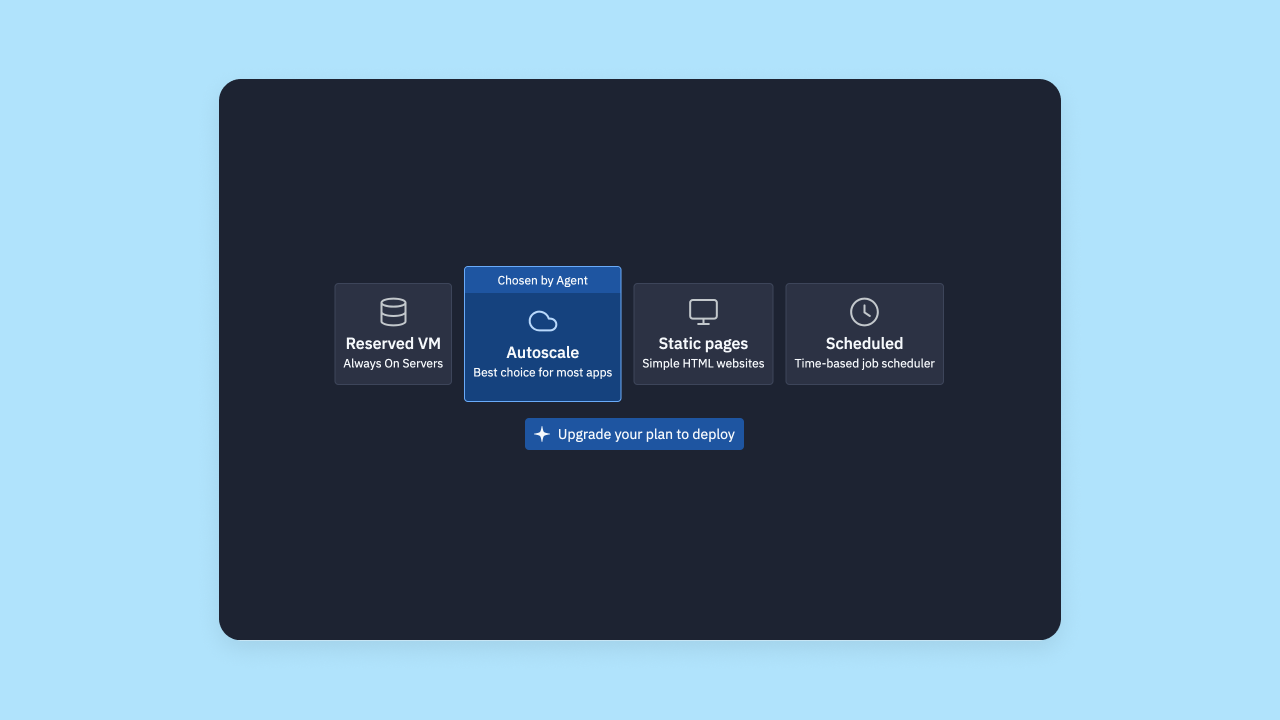
Which is better for deployment and hosting?
Bottom line: Bubble offers a slightly easier and more straightforward deployment and hosting process. Also, Bubble provides enterprise-grade security and privacy features on all plans, not just Enterprise ones.
Education
As AI makes software development easier, faster, and more accessible with less technical knowledge, educational materials may feel less essential. However, even as building becomes more accessible, it’s important to consider what educational materials and documentation your platform of choice provides for when you get stuck, need help troubleshooting, or want to go beyond the basics of the platform.
In this section, we evaluated the level and quality of education each platform provided.
Bubble education materials
Bubble is home to builders of all skill levels, so over the years we’ve built out a huge library of educational materials for all learning styles. If you’re new to building with AI, start with our course for Bubble beginners — Greg John will walk you through the basics of the Bubble platform, our visual programming language, and our AI tools.
For visual learners, our YouTube channel is another good place to start. You’ll find hundreds of videos covering everything from in-depth app design courses, bite-size lessons on how to build specific elements on Bubble, AI-app walkthroughs, recaps from our BubbleCon conference sessions, and more.
For those who prefer to read a guide, check out the Bubble Manual or visit the Bubble Academy. Our Academy has all kinds of resources, from getting started courses to step-by-step tutorials, one-on-one coaching, bootcamps, and more. If you get stuck at any point, you can always reach out to our active and engaged community in the Bubble Forum for help!
Replit education materials
Replit’s educational materials mostly fall under their YouTube channel. They have a decent number of videos covering quickstart guides, basic building tools, how-tos on specific elements and integrations, and a bunch of higher-level videos and walkthroughs.
Their technical documentation is a lot sparser. The basics are covered in the manual, and while they have a few tutorials, they’re quite random (i.e., a cat image generator and a Discord bot).
Since Replit’s platform and UX caters more to experienced developers, it makes sense that their video documentation focuses more on the platform itself, but beginners may find themselves getting stuck without as many resources as other tools provide.
Which is better for education and resources?
Bottom line: Bubble offers far more education resources and technical documentation — most notably, for every skill level. Advanced developers will find the technical docs they need to build complex functions and custom code, while beginners will have step-by-step walkthroughs and how-tos for every stage of the process.
Replit provides some education and documentation, but it’s neither as comprehensive nor as extensive as Bubble’s library.
Required technical expertise
You’ll remember in our discussion of the 80% rule above that no AI builder can really bring you a fully-functional app without any intervention or technical input. Even though AI may generate the app and most of the code for you, every platform requires some level of technical expertise to take the app from Day 1 to public launch.
In this section, we compare how technical each platform is beyond the initial code generation.
Bubble technical approachability
Anyone can build successfully on Bubble, regardless of your technical expertise. In part, that’s due to Bubble’s combination of a visual development platform alongside the option to add custom code as desired. It’s the best of both worlds, and supports a wide range of skill levels.
As a result, you’ll find apps built on Bubble by developers, product managers, founders, individual hobbyists, and everyone in between.
Of the AI-powered app builders we tested, though, Bubble is the best choice for non-technical builders. On Bubble, every part of the software development process is accessible for those without a technical background — not just the initial design mockups and MVPs. Because Bubble is built entirely on a visual programming language, you can control your workflows, data, logic, and functionality all visually — no code needed.
Starting with AI on almost any platform gives you a massive head start and speeds up development time exponentially. But Bubble makes it easier and more accessible to go beyond the Day 1 output that AI provides. Though a technical background can make it easier and faster to build on Bubble, someone without a technical background at all can make an app in just weeks on their own on Bubble.
Replit technical approachability
Replit is built more toward developers and learners who want an integrated, AI-assisted development environment. It’s also good for no-code users who feel they’re outgrowing simpler AI builders like Lovable.
This creates some pros and also some cons. On the plus side, Replit gives you more control throughout the whole process, and a familiar IDE with AI-assist for exponentially faster development time.
On the flip side, there’s more technical expertise needed and it’s less intuitive to use from step 1. For users who are fine with relying on AI for all changes and iterations, Replit does provide a pretty good AI-assisted iterative process. However, it’s a risky move as AI can be unpredictable at this point, and it can be easy to get stuck.
Which is better for required technical expertise?
Bottom line: Both Bubble and Replit are suited for builders without a technical background, but Bubble provides more support, community, and accessibility for non-programmers.
If you don’t know code, you’ll find yourself limited on Replit to what you can accomplish through AI. On Bubble, a visual editor gives you full control from start to finish. In addition, Bubble’s established community and extensive resources gives beginner developers and founders the support you need to solve problems, troubleshoot, and learn how to build and manage their app long-term.
Which is right for you?
Bubble and Replit both offer AI-powered app generation that takes less than 10 minutes to get up and running and generate functional frontend and backend features. Either tool can be useful for non-developers, but the way the tools function is very different and caters to different audiences.
Replit is essentially a programming environment with an integrated AI assistant, giving developers and others who are interested in learning code an all-in-one environment to build code, iterate on it manually or via AI, debug, and deploy their app. It’s streamlined, gives full access to your code, and provides speed via AI assistance.
Bubble is the only AI-powered visual development program that combines the speed of AI with scalability and control. It gives anyone the ability to create production-grade apps and enterprise software, without having to code. Even if you don’t have technical expertise, you get full control and customization through the visual editor, combined with the speed of AI generation to eliminate the blank-page dilemma and introduce you to the platform.
Plus, you get built-in hosting, a huge community with tons of resources, and a platform you can understand without a technical background, which makes managing and scaling your app accessible for anyone.
Where AI hits a wall or leaves you stuck in prompt purgatory, Bubble gives you full control without the guesswork or manual coding.
Of course, the best way to get a feel for a platform is to test it out for yourself. See how Bubble AI works and start building in our visual editor for free.
Build for as long as you want on the Free plan. Only upgrade when you're ready to launch.
Join Bubble
